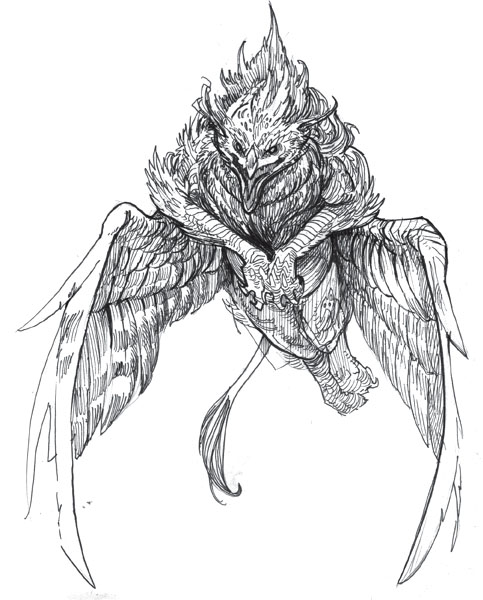Griffin

History
The griffin is by far one of the most common mythical creatures. It possesses the hind quarters of a lion and the wings and head of an eagle. In classical mythology, medieval bestiaries, heraldry and even contemporary fiction, the griffin is one of history’s favorite creatures, perhaps second only to the dragon. Various cultures from the Greeks, Romans, Arabians, Egyptians and throughout medieval Europe, have depicted the griffin in its own way.
A large predatory animal such as the griffin is likely to have come from a mountainous environment where it would be able to hunt fish and game. Although the griffin is depicted as early as the Sythian and Greek legends, it did not become commonplace until the Middle Ages. This leads one to believe that this predatory relative to the hippogriff and the shedu may have been particular to Western Europe, especially the Pyrenees and the Alps. After the Renaissance the griffin seems to have gone extinct around the seventeenth century, possibly due to hunting or competition from other European animals such as the wyvern. In North America, the mythos of the powerful eagle god is pervasive among native tribes who speculate that the European griffin may have had an American cousin.

In Heraldry, Griffins Commonly Depict Courage, Strength and Nobility

Medieval Stone Relief Depictions of Griffins

Griffin Decoration by Albrëcht Dürer, Circa 15th Century

Aerial View of Griffin

Renaissance Griffin, Circa 16th Century from The Triumph of Maximilian

Griffin in Profile
Demonstration
GRIFFIN


1 Concept and Design Stage
The griffin is one of the most illustrated legendary beasts from the ancient to the contemporary, and there is a plethora of great reference to choose from. When approaching the design of this classical creature, I wanted to give the animal a natural and realistic form while keeping with the traditional representations. To make the griffin more aerodynamically believable, I changed the traditional lion’s tail to a more avian tail for better flight dynamics. My goal was to show the graceful silhouette of the Falconiformes in flight—the diurnal birds of prey such as eagles, raptors and hawks.


John Tenniel’s Illustration from Lewis Carroll’s Alice’s Adventures in Wonderland

2 Skeletal Frame Sketch
Use simple circles and lines to sketch out the action pose of a large falcon in flight. Study the anatomy of wings to help get the perspective right.

3 Detailed Pencil Sketch
Add details in pencil such as the design of the plumage and texture of the lion’s legs. Loosely sketch another bird in the background to improve the believability of a bird in flight.

4 Underpainting and Finishing Details
Block in the basic colors over the sketch using semi-opaque colors, applied with broad and flat brushes. Use detailed brushes to further layer color, soften the background and refine the drawing.

Detail of Finished Griffin Head